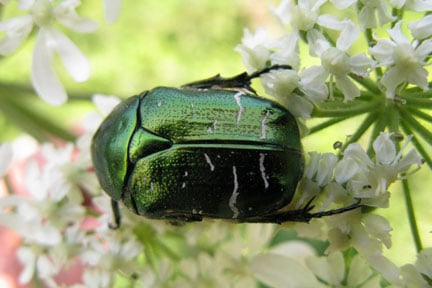Chafer grubs in garden borders
The large white c-shaped grubs of chafer beetles are sometimes found in gardens. Most do not cause problems, some feed on decomposing vegetable matter and help nutrient cycling. A few species can damage roots including some that feed on turf (see chafer grubs in lawns).

Quick facts
Plants affected Many do not damage plants
Main symptoms Large white c shaped grubs with three pairs of legs and a brown head
Caused by Larvae of a chafer beetles
Timing All year
What are chafer grubs?
All scarab beetles have c-shaped larvae that have a brown head and three pairs of legs, a form known as scarabiform. Some closely related beetle families (collectively known as Scarboidea) also have this form of larvae, including the rare stag beetle (Lucanus cervus, family Lucanidae, read more from Peoples Trust for Endangered Species), and the dor (also dung feeders dung) beetles (Family Geotrupidae). If the larvae were associated with buried dead wood (e.g. a tree stump) they are likely to be stag beetle grubs. Other endangered chafer species include the beautiful metallic green nobel chafer which inhabits decaying old trees. These can be mistaken for rose chafer but have wrinked winged cases as opposed to smooth.
The largest chafer beetle in Britain is the cockchafer or Maybug (Melolontha melolontha) and can reach 50mm in length. Adult maybugs are over 3cm in length and are often attracted to light. They are active during May. more information on this insect is available from the Wildlife Trusts.
A species of chafer grub is often found in
A few species of chafer can occasionally be a problem in garden borders, feeding on plant roots; these include the cockchafer and summer chafers (Amphimallon solstitiale). These have larvae that can feed in the soil for up to three years and occasionally damage the roots of plants.
Garden problems are caused by the smaller garden and Welsh chafers (Phyllopertha horticola and Hoplia philanthus) (up to 20mm) whose grubs are mainly found under turf where they can consume the root system. Animals such as foxes badgers and corvid birds often dig for these grubs in affected turf.
Symptoms
Chafer grubs found in compost heaps and organic rich soil are often Rose Chafer larvae which do not normally damage plants and are part of the composting process.
Where problem chafer species are present plants lack vigour and examination of plant roots will often show signs of being eaten. Large c-shaped grubs can also be found.
Damage to lawns can be more extensive, for more information see chafer grubs in lawns.
Management
Most species of chafer grub do not need control and are part of the biodiversity that gardens support. Species such as the rose chafer are beneficial. Other than in lawns, chafer grubs are rarely cause damage to garden plants.
Tolerate the presence of chafer grubs in garden borders, in some cases they are beneficial and they are easily confused with stag beetle larvae, which feed on dead tree roots.
Remove larvae of problem species from soil as they are found. Cultivation of the ground can briefly expose the grubs to predators, such as birds, and make the ground less attractive as egg-laying areas.
Biological control
You can buy pathogenic nematodes, usually Heterorhabditis bacteriophora, which enter the larvae and infect them with a fatal bacterial disease. The biological control is not specific to chafer grubs and other insects may be affected. These microscopic animals can be watered into the lawn or garden border when the ground is moist and soil temperature range between 12-20ºC. This biological control is available from some biological control suppliers and some garden centres. The ground around the edge of affected areas should be targeted to deal with larvae spreading out from “hot spots”. The nematodes should be applied as soon as possible after purchase, following the suppliers’ instructions. It may be necessary to water the soil before and after application to ensure the soil is sufficiently moist for nematode activity and survival.
Lures and traps are available for adult beetles however their effectivness is uncertain. Adults may be trapped after the damage has already occured.
There are currently no pesticides available to home gardeners for the treatment of insects in the soil
Download
Biological control suppliers (pdf document)
See also...
Protect your garden
UK Beetle recording information on Maybug/Cockchafer
UK Beetle recording information on summer chafer
UK Beetle recording information on rose chafer
UK Beetle recording information on stag beetles
UK Beetle recording information on dor beetles
People's Trust for Endangered Species- Nobel chafer
Get involved
The Royal Horticultural Society is the UK’s leading gardening charity. We aim to enrich everyone’s life through plants, and make the UK a greener and more beautiful place.